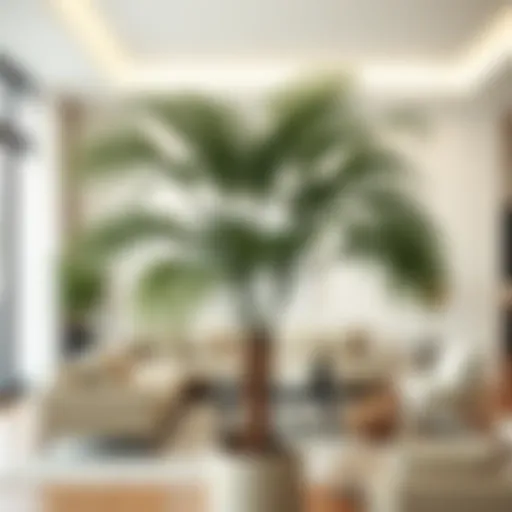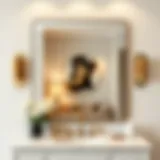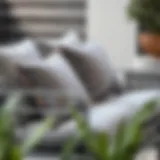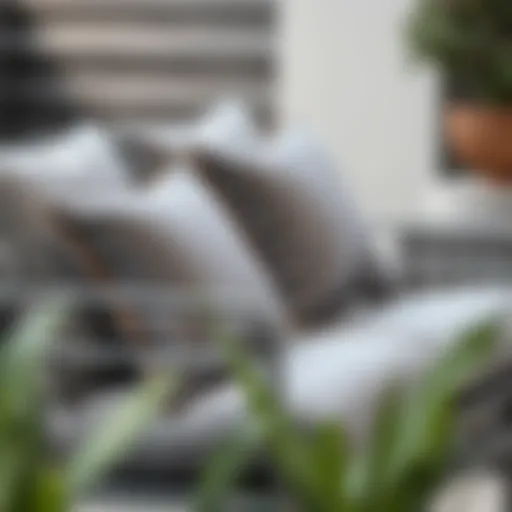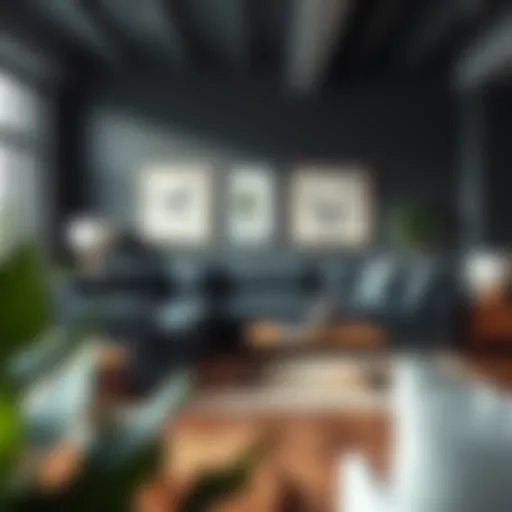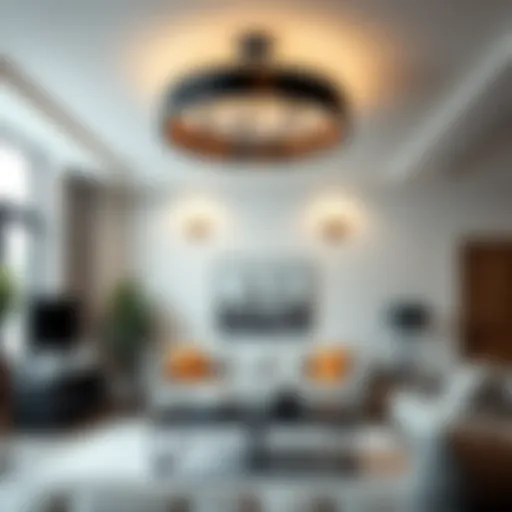Complete Guide to Choosing Patio Outdoor Cushions
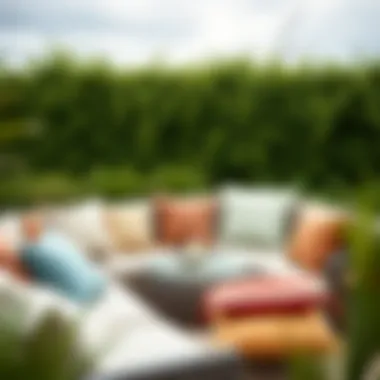
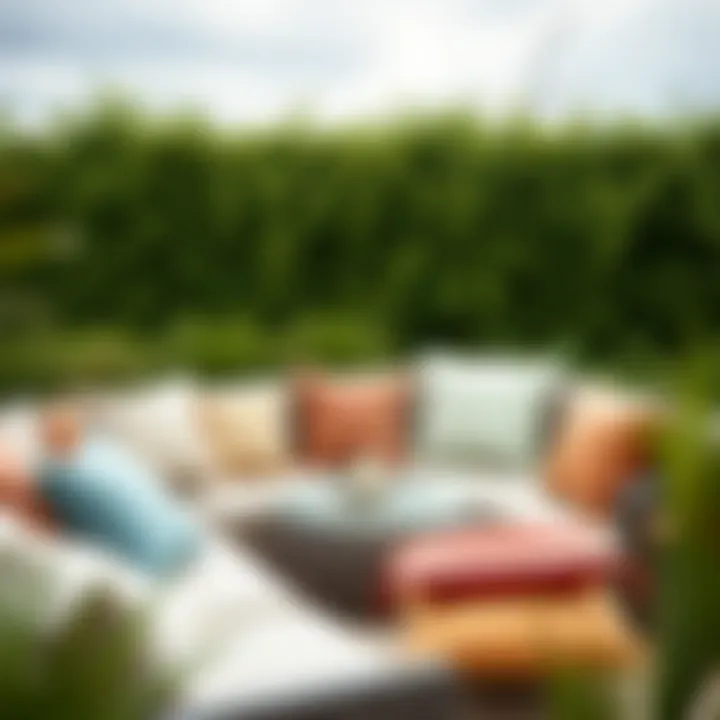
Intro
Creating a welcoming outdoor space often begins with the right patio cushions. They play a vital role in defining not just the comfort level of your furniture, but also its aesthetic appeal. Homeowners and renters alike are increasingly aware that choosing the right cushions can dramatically transform a mundane patio into an inviting prolongation of the home.
With a wide array of materials, colors, and textures available, selecting outdoor cushions requires careful consideration. Understanding current trends in design and materials can help you make informed decisions. Whether you’re a homeowner looking to freshen up your space, a renter trying to personalize a temporary dwelling, or a DIY enthusiast inspired to craft something unique, this guide has you covered.
Patio cushions are more than just decorative elements; they enhance comfort and can define the overall vibe of your outdoor area. So, let’s dive into the evolving trends that are making waves in the patio cushion market!
Understanding Patio Outdoor Cushions
Outdoor spaces have become essential extensions of our homes, evolving into areas where we gather, entertain, or simply unwind. At the heart of these outdoor retreats lies an often-overlooked element—patio outdoor cushions. These cushions not only add flair to your patio furniture but serve several crucial functions that enhance both aesthetics and comfort. Understanding patio outdoor cushions involves recognizing their various materials, designs, and maintenance needs, which all contribute to a more inviting outdoor space.
When we talk about the importance of patio cushions, we're not just referring to their role in comfort. They are also pivotal in setting the overall atmosphere of an outdoor area. Cushions come in a variety of colors and textures that can complement or contrast with your existing decor, allowing for personal expression in space design. Moreover, the materials used in these cushions are specifically selected for their ability to withstand the elements, making them vital for durability and long-lasting beauty.
In essence, grasping the ins and outs of patio outdoor cushions can lead to many benefits, including improved comfort for you and your guests as well as enhanced visual charm. From picking the right fabric to caring for your cushions, every choice matters to create that perfect outdoor oasis.
Definition and Purpose
Patio outdoor cushions are removable soft pads typically designed for use on outdoor furniture such as chairs, benches, or loungers. They are crafted to provide comfort and support while seated outdoors, serving a dual purpose of functionality and style. These cushions are often made with materials resistant to fading and moisture, making them suitable for various weather conditions.
Beyond mere comfort, they help in defining the character of your outdoor areas. For example, a vibrant red cushion can create a lively and energetic atmosphere, while muted pastel shades can lend a tranquil and welcoming feel. This versatility makes outdoor cushions an essential accessory for tuning the overall vibe of outdoor spaces.
Historical Context
The history of outdoor cushions can be traced back to ancient civilizations, where comfort during leisure was cherished. In Ancient Rome, for example, people would recline on cushioned benches during feasts, demonstrating early appreciation for comfort in outdoor settings. Fast forward to the Victorian era, and you see a blossoming of garden spaces decorated with plush cushions, emphasizing both grandeur and comfort.
In recent decades, there has been an evolution in materials and designs for outdoor cushions. The introduction of synthetic fabrics and waterproof foams in the late 20th century marked a significant shift, allowing cushions to endure harsher climates without losing their shape or color. Today, manufacturers often focus on eco-friendly materials, responding to a growing awareness of sustainability. Thus, the history of patio cushions is not only a tale of comfort but one that intertwines technology, art, and environmental responsibility.
Material Options for Outdoor Cushions
Selecting the right materials for outdoor cushions can make or break the comfort and aesthetic of your patio space. These choices are crucial not only for the look but also for practicality. The push-pull balance between style and function is where material options come into play. You want cushions that withstand the elements without sacrificing comfort or style. Here we delve into various fabric types and fill options, shedding light on their unique attributes, benefits, and drawbacks in an outdoor setting.
Types of Fabrics
Polyester
Polyester is a workhorse among outdoor cushion fabrics. One of its key characteristics is its durability; it can hold up against sun exposure without fading. This makes it a popular choice for homeowners who want colors to last through the seasons. Another unique feature of polyester is its water resistance, which helps in keeping cushions looking fresh even after a rain shower. However, it might not breathe as well as natural fabrics, making them uncomfortable in extremely hot weather.
In essence, polyester cushions are
- Long-lasting
- Easy to clean
- Versatile in colors and patterns
But be wary, as prolonged exposure to harsh weather can wear them out quicker if not maintained properly.
Acrylic
Acrylic fabric is another excellent choice for outdoor cushions, and its lightweight nature means it can easily be moved around. What sets acrylic apart is its fantastic UV resistance. It’s truly a camouflager, resembling natural fabric, yet maintains robust strength against fading. For someone looking for a cushion that can hold its own in both style and performance, acrylic checks those boxes.
Its unique features include:
- Soft feel, which gives a cozy vibe to your outdoor seating
- Resistant to mold and mildew
- Sheds water instead of absorbing it
However, the softer feel could mean it might not hold up as well against heavy-duty use as some other fabrics.
Sunbrella
Sunbrella is often heralded as the gold standard for outdoor cushion materials. Renowned for its resistance to stains, mold, and mildew, it is designed specifically for outdoor use. Homeowners appreciate its comprehensive color selection that doesn’t fade easily, maintaining its visual appeal for years.
Some of the standout features of Sunbrella include:
- Excellent fade resistance, keeping colors vibrant
- Easy to clean, usually just a soap-and-water solution will suffice
- Made from 100% acrylic fibers, allowing for breathability and softness
That said, it’s worth noting that Sunbrella cushions can be on the pricier side. The investment, however, often pays off given their longevity and comfort.
Foam and Fill Types
The choice of foam or fill directly affects how comfortable your cushions are. While looks matter, the feel is what you actually sit on. Here are the most common types of filling that you’ll encounter.
High-Density Foam
High-density foam is a top-tier choice when you want cushions that last. This foam offers excellent support, making it ideal for thicker cushions that can endure various weights. A standout characteristic is its ability to retain shape over years of use, meaning fewer replacements needed over time. Additionally, it's an ideal option if you want a firm feel that doesn't sag too quickly.
Some advantages are:
- Extended lifespan
- Comfortable and supportive
On the flip side, the price may be higher than other foams, making it a consideration if you're on a budget.
Polyester Fiberfill
This fill type offers a softer feel compared to high-density foam; it's fluffy, making it comfortable for lounging. One benefit is that it's lightweight, making it easy to move cushions around when needed. The unique feature of polyester fiberfill is its ability to loft up, providing a plush seating experience. However, it can compress over time, so regular fluffing may be necessary to maintain comfort.
Keep in mind, polyester fiberfill is:
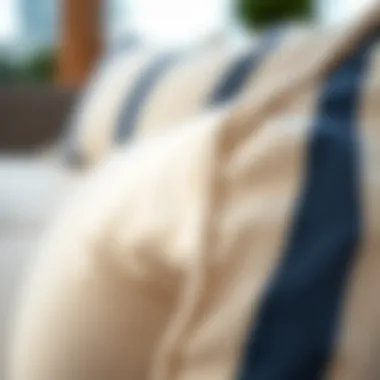
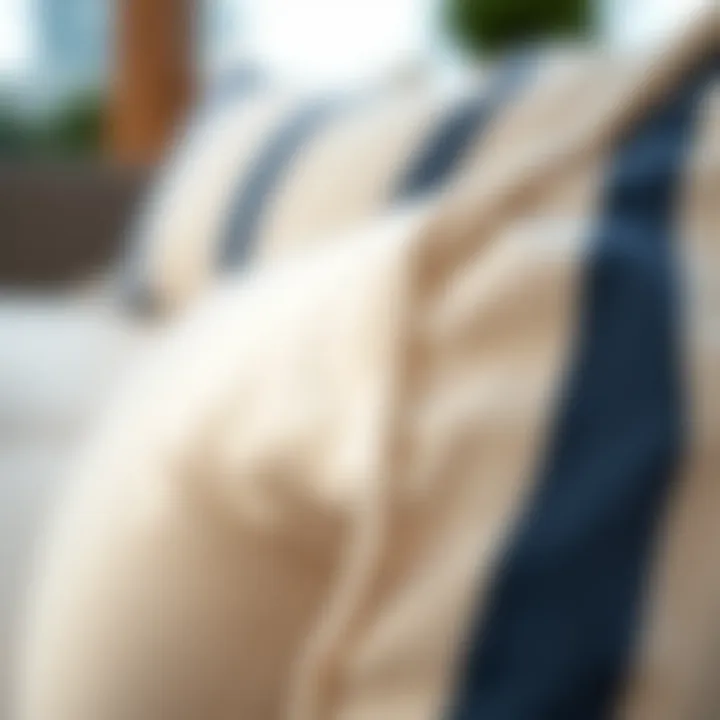
- Affordable
- Often used in less demanding setups
Yet, it lacks the durability of firmer fills, which can lead to quicker wear and tear.
Latex
Latex is a fill option that offers a unique combination of natural and modern features. Known for its resilience, latex provides better support and elasticity than traditional foam, making it a great option if you prefer a cushion that will bounce back after use. One standout attribute is its hypoallergenic qualities, making it ideal for outdoor settings where pollen may be an issue.
The pros of latex support its appeal:
- Naturally resistant to mold and mildew
- Excellent breathability, preventing overheating
But, this comes at a cost, as latex cushions can be pricier and may require careful handling to prevent loss of shape over time.
Design Considerations
When it comes to enhancing your outdoor space, design considerations for patio cushions play a central role. This isn't merely about aesthetics; it involves harmonizing comfort and style, ensuring that your outdoor area is as functional as it is inviting. Cushions can infuse color into a dull setting, or they can help create a soothing sanctuary, depending on your choices. Getting the design right can transform your patio from an overlooked corner to a cozy retreat.
There are several elements to consider when deciding on the design of your outdoor cushions:
- Color Schemes: The color of your cushions will impact the overall vibe of the area. In fact, colors can evoke various emotions and feelings. For instance, bright hues like coral or turquoise can add energy and vibrancy, making the space feel lively and cheerful. Soft pastels, on the other hand, can impart a sense of calm and serenity, perfect for a quiet evening on the patio with a book. Think about your existing decor; do you want to complement or contrast your current scheme?
- Patterns and Textures: Various patterns such as stripes, florals, or geometric shapes can add depth and interest. Mixing different textures can also enhance the tactile experience of your cushions; smooth fabrics paired with rougher ones can create a rich, layered look. Consider how these elements will interact with other aspects of your outdoor setup, such as tabletop decor or patio umbrellas.
In essence, design considerations in cushions aren't just about choosing what's visually appealing — it's about creating a cohesive outdoor environment that reflects your personal style and enhances your comfort. Furthermore, an informed design choice can yield a patio that resonates with elegance, whether for lively gatherings or tranquil moments.
Color Schemes
Choosing the right color scheme is crucial in setting the tone for your outdoor ambiance. It is wise to consider how the colors of your cushions harmonize with other outdoor elements. You might want to take cues from the surroundings, such as the green of the grass or the brown wood of the patio furniture. The interplay of colors can make or break the outdoor appeal.
Popular approaches to selecting color schemes could include:
- Monochromatic: Using different shades of a single color can create a striking and sophisticated look. For example, various tones of blue can mimic the ocean.
- Analogous: This scheme uses colors that are next to each other on the color wheel, such as yellow, yellow-green, and green, which gives a serene and harmonious feel.
- Complementary: Opposite colors on the wheel, like purple and yellow, can produce powerful, eye-catching designs when paired together.
Remember that the goal is to create a visual dialogue amongst all the elements in your outdoor space. Every color has its personality; be mindful to select ones that elevate your surroundings in the way you envision.
Patterns and Textures
Patterns and textures bring character to outdoor cushions, serving as an excellent opportunity for personal expression. They can play off the definitive elements around your patio, from the furniture design to additional decor items. For example, floral prints may contribute to a garden-like feel, where intricate geometric designs may invoke a more modern atmosphere.
When thinking about patterns, it could be beneficial to:
- Combine different patterns to create contrast, making sure to keep one dominant pattern to avoid overwhelming visual chaos.
- Think about how your patterns might interact with seasonal changes, as certain styles may feel more appropriate during summer whereas others fit winter's coziness better.
Texture should not be overlooked either, as it can elevate the sitting experience. A mix of textures — such as soft velvet alongside a more tactile canvas — creates visual interest and can enhance the seating comfort as well.
The key takeaway is to strike a balance that reflects personal taste while still maintaining a cohesive and inviting outdoor space. Ultimately, well-considered patterns and textures can inject life into any patio, making it a welcoming extension of home.
Sizing and Fit
When it comes to patio outdoor cushions, achieving the right sizing and fit can make or break the comfort of your outdoor space. Cushions that are too small may leave bare spots on furniture, while overly large cushions can be cumbersome and detract from the overall aesthetic appeal. The right fit ensures that your cushions not only look good but also provide optimum comfort and support.
Cushions serve a dual purpose: they enhance the visual appeal and add a layer of comfort to your outdoor seating. Therefore, knowing how to select the appropriate size is crucial for any homeowner or designer looking to create an inviting atmosphere.
Standard Dimensions
Standard dimensions for patio cushions can vary, but several measurements appear frequently across various types of outdoor furniture. These dimensions usually fit typical seating options like benches, chairs, and sectionals.
- Chair Cushions: The most commonly found sizes for chair cushions are
- Sofa and Love Seat Cushions: For wider seating areas, standard sizes are often
- Bench Cushions: If you’re furnishing a bench, you may find dimensions like
- 18 x 18 inches for square cushions
- 20 x 20 inches for larger lounge chairs
- 24 x 24 inches
- 26 x 24 inches for wider, deeper sofas
- 48 x 18 inches to fit two to three-seat benches comfortably
Having these standard dimensions at hand helps when visiting the store or browsing online. But remember, don't be afraid to measure your furniture to ensure a snug fit.
Measuring for Custom Cushions
If standard sizes don’t meet your specific needs, opting for custom cushions is an excellent route. This allows for the creation of cushions tailored to your furniture. Here are some steps to guide you in measuring for custom cushions:
- Measure Width: Start by measuring from the outer edges of your seat where the cushion will sit. If you have arms on the chair, make sure to account for that space.
- Measure Depth: Check how deep your seat is. From the front edge of your seat to the back of the sofa or chair, be precise in this measurement. A good rule of thumb is to include an extra inch for ease.
- Consider Thickness: Decide how thick you want the cushion to be. A thicker cushion often provides more comfort but can also change the look of your furniture.
- Account for Shape: If your furniture has curves or unique outlines, take the time to measure those aspects too. A proper fit will go a long way in looking polished.
- Use a Professional Tool: Consider using a fabric measuring tape for accurate results.
Tip: Double-check all measurements. "Measure twice, cut once" is the adage here, and it certainly rings true when dealing with custom cushions.
Ultimately, the right sizing and fit not only contribute to comfort but also enhance the visual symmetry of your patio. Carefully measuring and considering your options will lead you to the best choice for your outdoor space.
Comfort and Ergonomics
When it comes to patio outdoor cushions, the concepts of comfort and ergonomics are not merely optional; they are essential. As homeowners and design aficionados seek to create serene outdoor spaces, cushions play a pivotal role in merging functionality and aesthetic appeal. Understanding how to balance these aspects provides an opportunity to truly enhance your outdoor experience.
Assessing Comfort Levels
Assessing comfort levels in outdoor cushions involves more than merely sinking into a seat and deciding whether it feels good. This is a process that requires consideration of various factors including the filling type, firmness, and the cushion’s dimensions. For instance, high-density foam is renowned for its ability to retain shape while offering substantial comfort. This denotes that you'll feel cradled in comfort without being swallowed by the cushion itself.
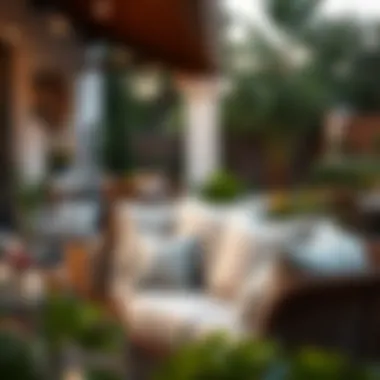
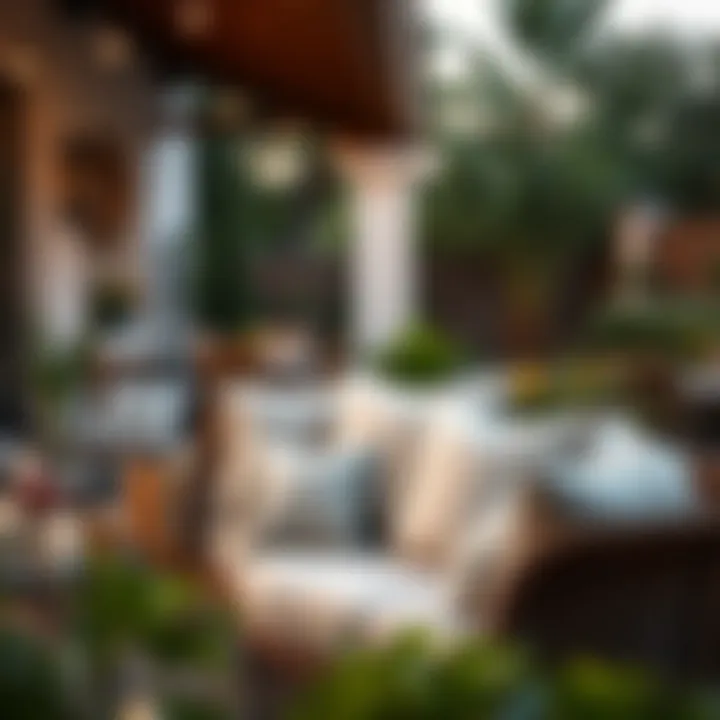
When evaluating the comfort of various cushions, it's crucial to consider personal preferences. Some folks might prefer a firmer seat as it offers better support, while others may opt for a softer option that allows for a leisurely sink-in feel. Additionally, think about how the patio will be used: if hosting family get-togethers or lounging with a book, the choices might differ significantly.
Key factors to assess:
- Density of foam or filling: Determines support and longevity.
- Cover material: Affects the overall feel against the skin—soft fabrics like cotton may be more inviting than rough textures.
- Cushion thickness: Thicker cushions provide more support but may look bulky; thinner cushions can be sleeker and more modern.
"Comfort is not just about feeling good; it’s about how the cushion corresponds to your needs and lifestyle."
Importance of Ergonomic Design
The importance of ergonomic design in outdoor cushions cannot be overstated. It addresses how the body interacts with the cushion, promoting good posture and minimizing strain. Poorly designed cushions, regardless of their aesthetics, can lead to discomfort, fatigue, or even long-term health issues. That’s why opting for cushions that support the natural curve of the body is instrumental.
Ergonomic features include:
- Lumbar support: Cushions designed to support the lower back help in maintaining spinal alignment, reducing the risk of back pain during extended use.
- Contoured shapes: These are tailored to fit the body more naturally, ensuring that even as one shifts positions, the level of comfort is maintained.
- Adjustable options: Cushions that can adapt to different sitting styles are incredibly valuable. This could mean a cushion with removable inserts or varying thickness that meets diverse user needs.
Outside of health considerations, ergonomic designs also lend themselves to a more sophisticated look. A well-designed cushion can harmonize with the existing decor and enhance the visual appeal of your space, offering a seamless blend of style and comfort.
Maintenance and Care
Maintaining outdoor cushions is essential not just for aesthetics but also for durability and comfort. Over time, exposure to the elements can lead to wear and tear, making it crucial for homeowners, renters, and designers to invest some effort into the upkeep of these outdoor accessories. Proper maintenance enhances their lifespan, ensuring that they remain a pleasant feature of your outdoor space rather than an eyesore of faded fabric and mildew. Here, we will delve into two key aspects of maintenance: cleaning and storage.
Cleaning Techniques
Keeping your patio cushions clean is vital in preserving their look and functionality. Here are some effective techniques to consider:
- Regular Dusting: An occasional shake or soft brush can do wonders, removing dust and debris before they settle into the fibers. Different cushions might require different approaches, like a light pat or a vacuum with a brush attachment, especially for cushions made with textured surfaces.
- Spot Cleaning: When faced with stains, don’t panic. Using a mild soap solution or a fabric cleaner designed for outdoor materials is a good start. Dampen a soft cloth with the solution and gently dab the stain—remember, scrubbing might cause more damage. Rinse with somewhere cooler water to remove any soap residue.
- Deep Cleaning: For a thorough cleanse, many outdoor cushions can be taken in for machine washing, particularly those with removable covers. Use a gentle textile cycle and skip the harsh detergents. If your cushions aren’t machine washable, consider using a foam cleaner and scrubbing gently—or, for tougher stains, a power washer on a low setting has been known to work wonders.
- Mold and Mildew Reclamation: If you find your cushions developing mildew, a solution of vinegar and water can help eliminate this nuisance. Spray on the affected area, let sit for a while, and then scrub gently. Rinse thoroughly and allow them to dry completely before putting them back.
Tip: Always check the care instructions provided by the manufacturer to ensure you're using the right cleaning methods for your specific materials.
Storage Solutions
Aside from cleansing them, how you store your cushions can have a significant impact on their endurance. Here are some practical storage strategies:
- Weather Resistant Bin: Consider investing in a storage container specifically designed for outdoor furniture. Make sure it’s waterproof, and that it has enough ventilation to prevent moisture build-up.
- Seasonal Solutions: During the winter months or when not in use for extended periods, it might be beneficial to store cushions indoors. A spare closet or even under your bed can work, just make sure they are clean and dry to avoid any unpleasant surprises later.
- Rolling Strategies: For those who need maximum mobility, rolling cushions and placing them in a large, breathable bag could be effective. This technique not only saves space but also minimizes creases and permanent marks on the fabric.
- Visual Aids: If you have a preferred arrangement for your patio, consider labeling your cushions based on size and color schemes. This way, when it comes time to set up again, it’s like following a trusty old recipe without second-guessing the ingredients.
Maintaining patio outdoor cushions might seem like a chore, but with the right approaches, it can be a simple and effective process. Doing so ensures your outdoor space stays inviting and comfortable for all who enjoy it.
Seasonal Considerations
When it comes to outdoor decor, an often overlooked detail is the impact of seasonal changes on your patio cushions. Each season brings its own set of challenges and considerations, impacting not only the lifespan of your cushions but also their overall functionality and appearance. Understanding these seasonal dynamics helps homeowners keep their outdoor spaces looking sharp while ensuring that cushions stay comfortable and welcoming.
By addressing seasonal considerations, you can avoid premature wear and tear on your cushions, which can often set you back financially. The elements play a significant role in how your cushions hold up over time, so being proactive allows for a longer-lasting investment.
Winter Storage Practices
When winter rolls in, many homeowners might have the urge to tuck away their patio furnishings as the temperature dips and the snow begins to fall. Properly storing your outdoor cushions is key to prolonging their life. Here are some effective practices:
- Clean Before Storing: It’s essential to ensure that cushions are clean before they're put into storage. Not only does this prevent mold and mildew buildup, but it also keeps them fresh for when it's time to use them again. Use a mild detergent with some water; a soft brush could help scrub any stubborn stains.
- Consider Water-Resistant Covers: If you can’t bring cushions indoors, invest in sturdy, water-resistant covers. These can safeguard against moisture, frost, and dust. Look for covers made from breathable fabric to prevent trapped moisture, which can lead to undesirable odors or degradation of materials.
- Use Vacuum Bags: If space is tight, utilizing vacuum-sealable bags can save you a good chunk of room. This method squeezes out air and reduces the bulk of your cushions, making storage a breeze.
Summer Protection Techniques
As the sun beams down and temperatures rise, outdoor cushions can be at risk of fading, degrading, and becoming uncomfortable if they are not adequately protected. Here are a few techniques you might consider during the summer months:
- Positioning Matters: If possible, place your seating in shaded areas. It may not always be doable, but rotating cushions can help minimize sun exposure, which is notorious for fading colors. Moving cushions around regularly can also give them a chance to "even out" any discoloration.
- Strategic Usage of Umbrellas: Utilize umbrellas for shade over your seating areas. They not only provide comfort but can also impede direct sunlight from hitting your cushions all day long.
- Regular Cleaning: Just like winter, summer sees its fair share of allergens, pollen, and dust. Regular cleaning will keep your cushions looking vibrant. Smart ways to clean include a quick rinse with a hose every now and again. Always check the manufacturer’s recommendations for fabric care.
Pro Tip: By understanding and mitigating the effects of seasonal changes, you can extend the longevity and beauty of your patio cushions, making them an enduring feature of your outdoor space.
Adapting to seasonal considerations for your outdoor cushions is not all about preservation. Ultimately, it's about ensuring a welcoming and aesthetically pleasing environment, regardless of the time of year.
Sustainability and Eco-Friendly Options
As the world becomes increasingly aware of climate change and environmental issues, the importance of sustainability in outdoor living spaces has risen to the forefront. Homeowners are not just looking for comfort and aesthetics when it comes to patio outdoor cushions; they are also seeking options that minimize their ecological footprint. Embracing sustainability in this context means choosing cushions made with eco-friendly materials and considering the broader impact of how these products are manufactured and disposed of. This not only benefits the planet but adds value to your outdoor oasis, making it a space that reflects your commitment to the environment.
Recycled Materials
When looking for cushions that won't leave a dent in Mother Nature, recycled materials come into play as a star player. Manufacturers have begun to tap into the potential of turning waste into beauty. For instance, cushion covers made from recycled plastics, like PET bottles, are not only stylish but also contribute to reducing landfill waste.
Using such materials can offer numerous environmental benefits:
- Reduced Resource Consumption: Recycling existing materials lessens the need for raw materials, conserving resources like water and energy during production.
- Lower Carbon Footprint: Processes involved in recycling typically emit fewer greenhouse gases compared to traditional manufacturing.
- Durability: Often, products made from recycled materials are designed with longevity in mind, which means less frequent replacements and, ultimately, less waste.
"Sustainability is no longer optional; it’s essential for the health of our planet and the future generations."
Impact of Manufacturing Practices
The impact of manufacturing practices on sustainability can be profound. Not all cushions are born equal; the pathway from raw material to finished product plays a crucial role in determining a cushion’s environmental footprint. Here are several key practices to consider:
Energy Efficiency
Emphasis on energy-efficient production methods can significantly reduce the overall environmental impact of outdoor cushions. Manufacturers that utilize renewable energy sources, such as solar or wind, help minimize carbon emissions associated with traditional energy sources.
Sustainable Sourcing
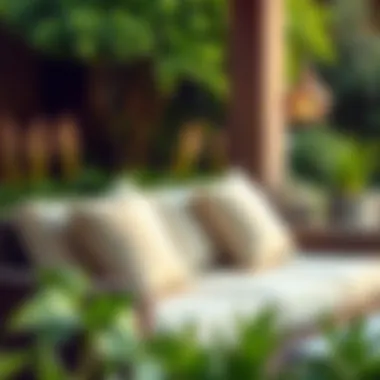
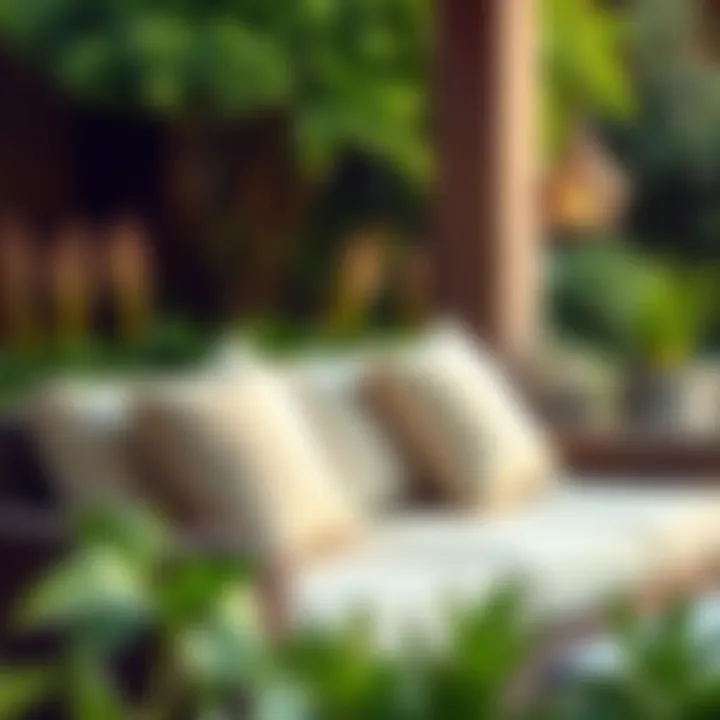
Sourcing materials responsibly is another critical factor. Companies can make a conscious effort to source fabrics and fillers that are produced through sustainable methods. This aspect helps to ensure that from growing cotton to creating synthetic materials, the processes employed are environmentally friendly.
Waste Management
Consider how manufacturers manage their waste. The best firms recycle excess materials and employ processes that limit waste generation. Some even have take-back programs where customers can return worn-out cushions for proper recycling.
Choosing the Right Cushions for Your Space
Selecting the ideal patio cushions goes beyond mere preferences in color and fabric. It involves a thoughtful integration of design elements, comfort needs, and the existing outdoor setup. Choosing the right cushions can greatly enhance both the functionality and aesthetics of your outdoor space, making it a haven for relaxation and social gatherings.
When cushions harmonize with outdoor furniture, the entire space feels cohesive. The main goal is to create an inviting atmosphere without overwhelming the senses. Here, keeping in mind the balance of colors, textures, and overall design is key. A misaligned cushion can diminish the charm of even the most carefully curated patio.
Matching with Existing Furniture
In the world of patio decor, the cushion-furniture match can be a game changer. Imagine your vibrant red cushions clashing with a muted gray sofa – not quite the ambiance one desires. To avoid such unfortunate mismatches, consider the following:
- Color Coordination: Select cushions that complement the shade of your existing patio furniture. If you have natural wood finishes, earth tones might work well. For metal furniture, bright or bold colors can contrast beautifully.
- Fabric Compatibility: The material is another crucial factor. If your furniture features a sleek metal finish, go for smoother fabrics like acrylic. On the flip side, if you’ve got wicker furniture, soft, textured fabrics can enhance that organic vibe.
- Shape and Size: Cushions don’t just come in one shape or size. They should reflect the contours of your furniture. Square cushions lend a modern touch, while rounded ones can have a softer appeal. Choose cushions that mirror the lines and shapes of the existing pieces to maintain visual continuity.
Layering for Aesthetic Appeal
Adding layers of cushions is a fantastic method to elevate your outdoor space. Layering invites depth and intrigue while allowing for different patterns and textures to coalesce without chaos. Here’s how to effectively layer your cushions:
- Mix and Match: Don’t shy away from combining patterns. For instance, a solid color cushion can provide a backbone to busier prints. Use one patterned cushion as a focal point, surrounded by solids that echo a color found in the pattern. This technique can help create visual interest.
- Varied Sizes: Layering does not mean all cushions must be the same size. Mixing large and small cushions can make seating look plush and inviting. Picture a deep-seated lounge chair with larger cushions at the back and smaller ones at the front for an appealing look.
- Textures Matter: Just like with color, layering different textures can add substantial interest. Think about incorporating materials like canvas, velvet, and cotton together. This not only enhances visual aesthetics but also increases tactile pleasure for those lounging in your space.
"The most inviting outdoor areas are those that harmoniously blend functionality with innovative design choices".
Trends in Outdoor Cushion Design
Design is ever-evolving, and when it comes to outdoor cushions, it's no different. Understanding current trends helps homeowners, designers, and retailers stay in the loop while providing cushions that not only enhance aesthetics but also improve outdoor experiences. Following these trends can transform a dull patio into a vibrant oasis, encourage comfort, and reflect one’s personal style.
Current Aesthetic Preferences
The aesthetic appeal is critical. Homeowners these days are drawn towards a blend of functionality and flair. Popular colors lean towards earthy tones, such as terracotta, olive green, and muted blues, that reflect nature, promoting a serene atmosphere. Bright pops of color often come through in accessories and patterns.
In terms of patterns, geometrics and nature-inspired designs are at the forefront. For instance, cushions with leaf motifs or simple stripes bring in a fresh vibe without overwhelming the senses. There's also an increasing push towards minimalism, where less is more. Clean lines and solid hues are favored, especially among those who prefer a more modern look.
Influencers and designers now advocate for mixing and matching these aesthetic elements, resulting in a layered look that feels both purposeful and stylish. As one decor expert noted:
"Mixing patterns can create interest, but it's essential to have an anchor point—something solid to pull it all together."
Through these design choices, homeowners not only reflect their personalities but also create spaces that encourage relaxation and connection with nature.
Innovative Products in the Market
The modern outdoor cushion market is bursting with innovation, driven mainly by consumer demand for sustainability and performance. One standout in recent product offerings is the use of solar-powered cushions. These cushions come equipped with solar panels that charge built-in USB devices during sunny days, eliminating the fuss of tangled wires and power outlets outdoors.
Another noteworthy advancement is in the realm of water-repellent fabrics. Brands like Sunbrella have developed textiles that resist moisture, fading, and stains better than ever before, ensuring cushions keep their chic look for years. Foam technology has also seen strides with high-resiliency foam that maintains its shape even after repeated use, which is crucial for comfort.
Even the manufacturing processes have had a shake-up. Many companies are adopting practices that utilize recycled materials and eco-friendly production techniques. This not only reduces the carbon footprint but also attracts environmentally conscious consumers.
In summary, whether it's about enhancing comfort, integrating technology, or committing to eco-sustainability, the trends in outdoor cushion design reflect changing tastes and priorities of today’s consumers. Both designers and homeowners should embrace these trends to ensure that their outdoor spaces are not just functional, but also reflective of the times.
Shopping Tips for Patio Cushions
When it comes to selecting the right patio cushions, the importance of having a good shopping strategy can’t be understated. You wouldn’t buy a car without taking it for a test drive, right? The same principle applies to cushions—be it for aesthetic appeal or comfort. Understand that shopping for outdoor cushions involves several elements, including the selection of materials, pricing, and styles that blend with your existing outdoor setup. Here are some important considerations to help guide your selection process.
Where to Buy
Finding the perfect patio cushions starts with knowing where to shop. The market is rife with both online and physical retailers, but each presents its own pros and cons. Here are a few places worth considering:
- Home Improvement Stores: Retailers like Home Depot or Lowe's typically offer a wide array of outdoor cushion options. They often provide quality cushions at competitive prices.
- Specialty Outdoor Stores: Shops that focus on outdoor living often have an extensive selection of unique styles. These cushions are more tailored to specific outdoor settings.
- Online Marketplaces: Websites like Amazon or Wayfair have user-friendly platforms that let you browse thousands of options from the comfort of your home. Customer reviews can give you insights into durability and comfort.
- Furniture Stores: Some retailers, like IKEA or Ashley Furniture, have seasonal selections. Their cushions often come with complementary furniture, which is handy if you’re going for a cohesive look.
Visiting multiple stores allows you to compare and contrast the quality and prices on offer. Make a point to check out seasonal sales, as many retailers have discounts that can significantly ease the financial burden of re-decorating your patio.
Online vs. In-Store Shopping
The age-old debate of online versus in-store shopping is relevant here as well. Both have their advantages and it’s crucial to weigh them against your situation.
- Online Shopping:
- In-Store Shopping:
- Convenience: You can shop at any time without leaving your home.
- Wider Selection: The internet provides access to thousands of products, often more than what any local store can stock.
- Price Comparisons: It’s easier to browse and compare prices on different sites. This means you can hunt for the best deals without the hassle of store-hopping.
- Tactile Experience: You can physically examine the cushions. You can feel the fabric and understand how comfy they are by sitting on them.
- Immediate Purchase: There’s no waiting for shipping, and you can begin enjoying your new cushions right away.
- Personal Assistance: Retail staff can give advice or help you find something specific that fits your needs. Sometimes, a slightly experienced eye can spot what’s best for your situation.
In the end, the choice largely depends on your personal preference and comfort level with technology. If you feel confident shopping online and assessing options through reviews, that might be the way to go. Otherwise, a hands-on approach might offer the satisfaction and clarity you’re looking for. The key takeaway is to be thorough, do your homework, and don’t rush—after all, your outdoor oasis deserves the best cushions it can get.
Closure
When we draw the curtains on our exploration of patio outdoor cushions, it’s crystal clear that these seemingly simple accessories pack a hefty punch in enhancing our outdoor spaces. While they might not command the same attention as a stunning outdoor sofa or a sprawling patio, outdoor cushions serve pivotal roles that extend far beyond mere aesthetics. They contribute to comfort, allowing people to linger longer outdoors, and can transform a standard set of furniture into a cozy haven, perfect for mingling or curling up with a book.
One mustn’t underestimate how crucial the right choices in cushions can be. We're talking about the marriage of style and substance here. The fabric trim can be a bright conversation starter, while the right fill can mean the difference between a fleeting visit to the patio and an extended evening under the stars. Homeowners might want to consider color schemes and textures that either complement or contrast with their existing setups; after all, creating an inviting atmosphere is about more than just picking pretty colors.
Moreover, practical maintenance needs cannot be overlooked. Investing time in proper care is key to prolonging the lifespan of outdoor cushions. Seasonal practices such as appropriate storage or protective measures during harsher weather conditions ensure that cushions remain as welcoming as the day they were bought.
Lastly, as sustainability becomes increasingly significant, opting for eco-friendly materials isn’t just a buzzword; it’s a responsibility. By choosing cushions crafted from recycled materials and employing mindful manufacturing practices, one can create an outdoor space that reflects not just a personal style but also a commitment to the environment.
So, let's summarize a few key points for clarity:
- Comfort and Ergonomics: Cushions enhance physical comfort and support for long outdoor gatherings.
- Design Choices: Colors and patterns can redefine a space, making it inviting and visually appealing.
- Maintenance: Regular cleaning and seasonal storing extend the life of your cushions and retain their appearance.
- Sustainability: Eco-friendly options show a commitment to both style and environmental responsibility.
In the end, patio cushions serve as more than just decorative pieces; they're essential touches that evoke warmth, comfort, and style in our outdoor living spaces. By thoughtfully considering each aspect outlined in this guide, readers can confidently curate a patio that not only pleases the eye but also invites everyone to enjoy the great outdoors.



